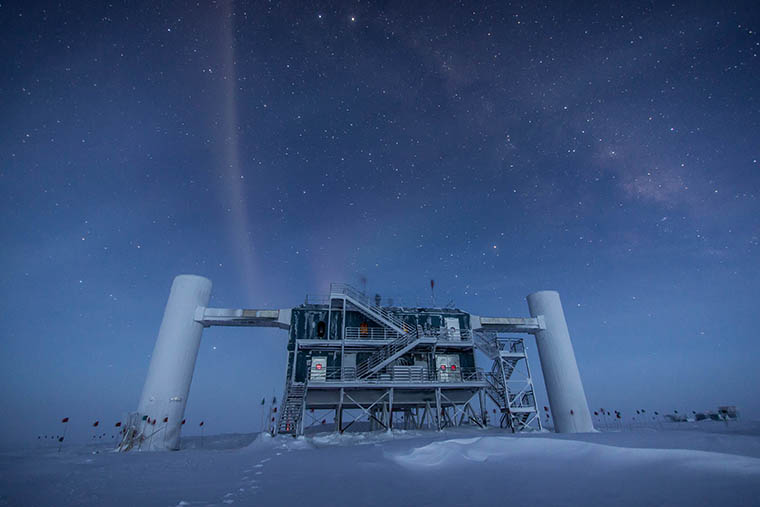Feb 3 2020
A technique for using data from ultra-high energy neutrinos to analyze interactions that do not fall into the standard model of particle physics has been developed by physicists from Washington University in St. Louis.
 Physicists in Arts & Sciences have proposed a new way to leverage data from large neutrino telescopes such as the IceCube Neutrino Observatory in Antarctica. Image Credit: Felipe Pedreros/IceCube and National Science Foundation.
Physicists in Arts & Sciences have proposed a new way to leverage data from large neutrino telescopes such as the IceCube Neutrino Observatory in Antarctica. Image Credit: Felipe Pedreros/IceCube and National Science Foundation.
The researchers’ “Zee burst” model utilizes new data obtained from large neutrino telescopes, for example, the IceCube Neutrino Observatory located in Antarctica and its future extensions.
“Neutrinos continue to intrigue us and stretch our imagination. These ‘ghost particles’ are the least understood in the standard model, but they hold the key to what lies beyond,” stated Bhupal Dev, assistant professor of physics in Arts & Sciences and author of a new study published in Physical Review Letters. Dev is also part of Washington University’s McDonnell Center for the Space Sciences.
So far, all nonstandard interaction studies at IceCube have focused only on the low-energy atmospheric neutrino data. The ‘Zee burst’ mechanism provides a new tool to probe nonstandard interactions using the ultra-high energy neutrinos at IceCube.
Bhupal Dev, Assistant Professor of Physics in Arts & Sciences, Washington University in St. Louis
Ultra-High Energy Events
Neutrino oscillations were discovered 20 years ago, the 2015 Nobel Prize in physics was awarded for this discovery. Since their discovery, researchers have achieved considerable advances in gaining insights into the properties of neutrinos. However, a lot of questions are still unresolved.
For instance, since neutrinos have such a tiny mass, due to which researchers must consider theories other than the standard model. In such theories, “neutrinos could have new nonstandard interactions with matter as they propagate through it, which will crucially affect their future precision measurements,” stated Dev.
The IceCube collaboration announced the first-ever detection of ultra-high energy neutrinos from extraterrestrial sources in 2012. This discovery paved a new path toward the investigation of the properties of neutrinos at the highest possible energies. From then, IceCube has announced 100 such ultra-high energy neutrino events.
“We immediately realized that this could give us a new way to look for exotic particles, like supersymmetric partners and heavy decaying dark matter,” stated Dev. In the last several years, Dev had been seeking ways to detect signals of new physics at various energy scales and had co-written half a dozen papers investigating the possibilities.
“The common strategy I followed in all these works was to look for anomalous features in the observed event spectrum, which could then be interpreted as a possible sign of new physics,” he added.
The most splendid characteristic would be a resonance: what is observed by physicists as a dramatic improvement of events in a narrow energy window. Dev spent time contemplating new scenarios that could result in such a resonance feature. Eventually, this led to the concept for the current study.
According to the standard model, neutrinos with ultra-high energy have the ability to generate a W-boson at resonance. This process, called the Glashow resonance, has already been observed at IceCube, as per initial results reported at the Neutrino 2018 conference.
We propose that similar resonance features can be induced due to new light, charged particles, which provides a new way to probe nonstandard neutrino interactions.
Bhupal Dev, Assistant Professor of Physics in Arts & Sciences, Washington University in St. Louis
Bursting onto the Neutrino Scene
Dev and his co-author Kaladi Babu from Oklahoma State University took the Zee model, a well-known model of radiative neutrino mass generation, as a prototype for their research. This model enables charged scalars to be as light as 100 times the mass of protons.
“These light, charged Zee-scalars could give rise to a Glashow-like resonance feature in the ultra-high energy neutrino event spectrum at the IceCube Neutrino Observatory,” stated Dev.
In the Zee model, the new resonance involves charged scalars. Therefore, the researchers decided to name it the “Zee burst.”
Wide-scale event simulations and analysis of data by Yicong Sui from Washington University and Sudip Jana from Oklahoma State University, both graduate students in physics and co-authors of this study, revealed that such a new resonance can be detected using IceCube data.
“We need an effective exposure time of at least four times the current exposure to be sensitive enough to detect the new resonance—so that would be about 30 years with the current IceCube design, but only three years of IceCube-Gen 2,” stated Dev, speaking about the suggested next-generation extension of IceCube with a detector volume of 10 km3.
This is an effective way to look for the new charged scalars at IceCube, complementary to direct searches for these particles at the Large Hadron Collider.
Bhupal Dev, Assistant Professor of Physics in Arts & Sciences, Washington University in St. Louis
This study was funded by the U.S. Department of Energy and the U.S. Neutrino Theory Network Program.